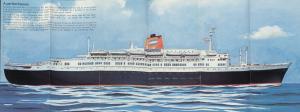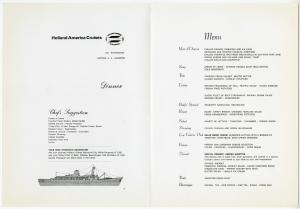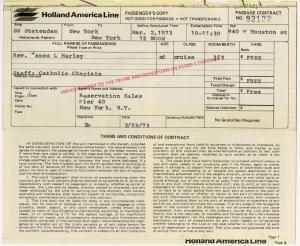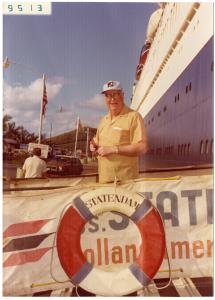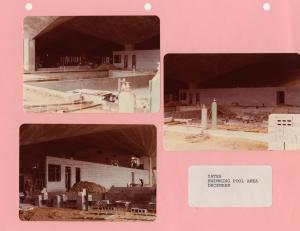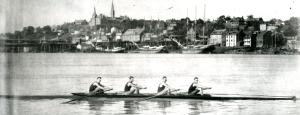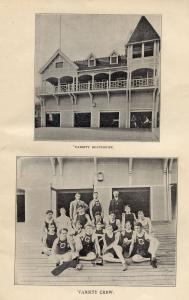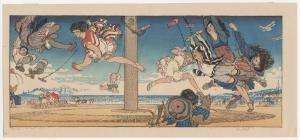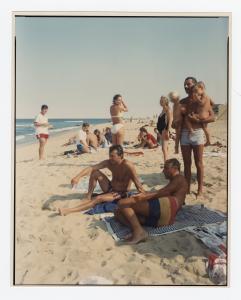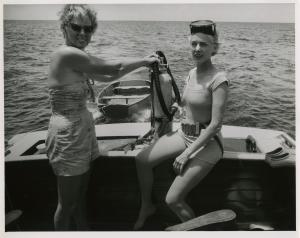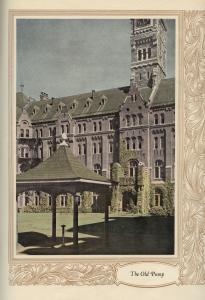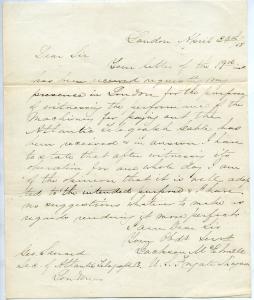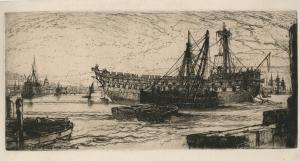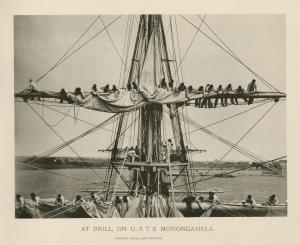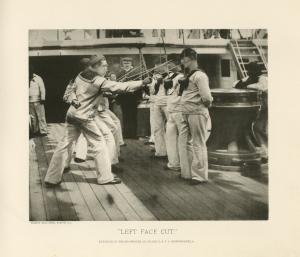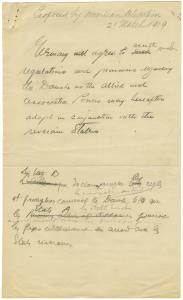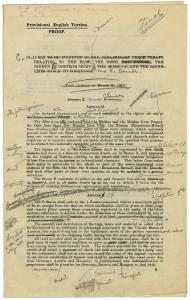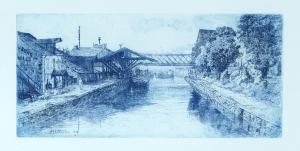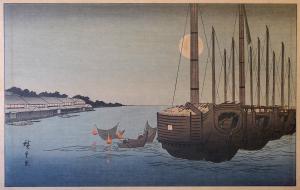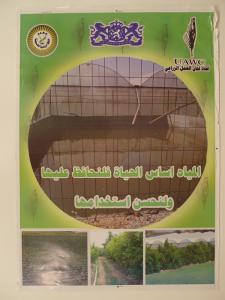This exhibition celebrates the vital bond between human life and the element of water. It complements the student exhibition on the fourth floor of the Library which likewise highlights the role that water plays in our daily lives. The title expresses the love and respect we have for our waterways and the need to cultivate care for our watersheds.
This fifth floor exhibition was assembled by the curatorial team from the Booth Family Center for Special Collections and is arranged in four thematic sections. The Fairchild Gallery presents the religious and symbolic representations of water on the east wall, and climate change concerns on the west wall. The two Special Collections cases along the aisle leading to the Murray Room explore the recreational uses of water and the use of water as a vital resource for various purposes from agriculture to navigation. The items on display are selected from University Archives, Rare Books, Manuscripts, and Art holdings of the Library. These non-circulating materials are available to researchers in the Booth reading room when not on display.
The exhibition was inspired by a poetic water-harvesting project of the same title using both digital and mail-art participation conceived by Gretchen Henderson in collaboration with the University of Arizona Poetry Center and the Wick Poetry Center at Kent State University. The Library is partnering with GREEN (Georgetown Renewable Energy and Environmental Network) to collect works of art, poems, and love letters to bodies of water in response to the related exhibitions on the fourth and fifth floors.
Religious/Symbolic
Le Roi d’Ys (Act 1, Scene 2)
Édouard Lalo
(French, 1823-1892)
mid-1870s
Leon Robbin Collection of Music Manuscripts and Letters of Composers
GTM-941229
La Roi d’Ys, an opera in three acts, is based on the Atlantis-like legend of Ys, a mythical submerged island off the coast of Brittany. A tale of dynastic marriage, sibling jealousy, treachery, remorse, and suicide, it portrays the ocean’s submersion of the island as divine retribution for human arrogance and sin.
Gilgamesh
Translated by William Ellery Leonard; Illustrated by Irving Amen
Avon, Conn : Limited Editions Club, 1974
Rare Books Collection
General ; 00B14
As in the biblical story, the ancient Sumerian epic of Gilgamesh tells of a great flood that wipes out nearly all of humanity. In this version, the flood carries no moral intent but instead reflects the caprice of the gods.
The Chester Play of the Deluge
Illustrated by David Jones
Waltham Saint Lawrence, Berkshire: Golden Cockerel Press, 1927
Gift of George M. and Penelope Berringer
Rare Books, General Collection Folios, 90B15
Having learned wood engraving just a few years earlier, David Jones went on to create several masterpieces—including the Chester Play of the Deluge—before abandoning the medium in 1930 due to eye strain. Jones often explored the spiritual symbolism of water in his art, with the Flood embodying the unity of endings and beginnings, of God, nature and humankind.
Now, Ever Alake, My Master Dear, I Fear a Deadly Storm! from The Ballad of Sir Patrick Spens
Anne Ryan (1899 – 1954), artist
Walter Scott (1771 – 1832), author
1947
Woodcut on black paper
Art Collection purchase, 1990
1990.5.20
Artist and poet Anne Ryan revolved among the emerging Abstract Expressionist painters and literary figures of the 1930s and 1940s in New York’s Greenwich Village. She began making prints while studying with British artist Stanley William Hayter, who established his influential workshop known as Atelier 17, transferred from Paris during World War II. This unusual woodcut printed on black paper is based on an old English ballad in the oral tradition. First published in 1765, the story is about an ill-fated Scottish voyage to Norway commanded by the king.
St. Paul Breaks Bread
David Jones
(British, 1895 – 1974)
Wood engraving
Design by Jones engraved by Eric Gill
Michael Richey Papers 2
GTM-GAMMS321, box 1 folders 34 & 53
This engraving was a 1938 commission for Eric Gill to illustrate the ordination card of a Trappist monk. Gill asked David Jones to create a drawing for him to engrave, resulting in this white-line print depicting a scene from the Acts of the Apostles: St. Paul calmly breaking bread on a ship soon to be wrecked off the coast of Malta. When he saw the seagulls in Jones’ drawing, Gill is said to have remarked, “I wish that I could do that.”
The Rime of the Ancient Mariner with Ten Engravings on Copper by David Jones
Samuel Taylor Coleridge
Bristol, England : Douglas Cleverdon, 1929
Rare Books Collection
Cube ; PR4479 .A1 1929b
Coleridge’s work inaugurating the British Romantic movement continues to captivate readers with its haunting tale of a seaman cursed for the wanton killing of an albatross. Among its many symbolic dimensions, the ocean is evoked—both in the poem and in David Jones’s illustrations—as a site of alienation, supernatural judgment, and sublime enchantment.
Somos Agua que Nutre la Tierra…
Ismini Black, artist
La Linterna (est. 1934), publisher
2024
Linocut with letterpress on Earth Pact (bagasse) paper
186/210
Fairchild Endowment Fund purchase, 2024
2024.14.13
The text of Somos Agua is a declaration from the Putumayo River in Colombia, which nourishes and persists. Black states that the river “resonates with the strength and persistence of the women of this area, who are one of the greatest examples of resistance, fluidity, and adaptation.”
The Odyssey
Translated by Walter Shewring
1980
Walter Shewring Papers
GTM-GAMMS190 box 2 folder 2
Walter Shewring’s translation of The Odyssey was published by Oxford University Press in 1980. Bodies of water appear throughout the work, particularly the famous 'wine-dark' sea, all of which partake in a divine nature as illustrated in the description of Odysseus’ shipwreck on the island of Calypso in the fifth book.
Mare Nostrum
Islam Aly
Cairo, Egypt : 2022
Rare Books Collection
Vault ; N7433.4.A49 M37 2022
Aly’s work is highly tactile and symbolic, exploring the interplay between the mythic Egyptian imagery of the pharaoh’s ship-bound passage through the underworld and present-day refugee journeys across the Mediterranean in search of safety. For millennia, the Mediterranean—Mare Nostrum (“Our Sea”) to the ancient Romans—has served as both a literal and metaphorical passage to salvation, freedom, and peace.
Boat Wake
Pete Turner
(1934 – 2017)
1966 (printed 2003)
Dye transfer print
Gift of Charles and Jennifer Heckelman, 2004
2004.11.4
Boat Wake was taken in one of the large fjords in Scandinavia. Turner describes the water’s ripples as being a visual representation of the sound of the boat’s engine. The image is a delightful synergy between light waves, sound waves, and water waves.
Narcissus
Lila Oliver Asher
(1921 – 2021)
Undated
Linocut on paper
Gift of Ingrid Rose in memory of Milton M. Rose, 2018
2018.4.58
Lila Asher was a prolific linocut printmaker who taught at Howard University for more than three decades. Here she portrays the legendary Greek god Narcissus who was so handsome that he fell in love with his own reflection in a pool of water. Due to his vanity, Narcissus rebuffed the advances of the admiring nymph Echo. His self-imposed loneliness led him to pine away and transform into the white and yellow spring flower that bears his name today.
The Pool
Albert Winslow Barker
(1874 – 1947)
1932
Lithograph on paper
Edition of 50
Art Collection purchase, 1995
1995.12.3
Albert Barker was a colorblind artist who worked primarily in lithography, a monochrome medium that can generate a varied tonal range in lieu of color. Barker obtained a PhD in Greek from the University of Pennsylvania and was clearly inspired by classical mythology. The subject of this lithograph, a classical female nude in a natural setting, is typical of Art Deco imagery. Such idealized scenes as nymphs beside a body of water were emblematic of purity, tranquility, and the promise of spring.
Untitled [Man and Mermaid Embracing] from the portfolio Abaeté: Dez Xilogravuras de Calasans Neto
Calasans Neto
(1932 – 2006)
1979
Woodcut on paper
Gift of Jose M. Neistein, 2008
2008.18.3.8
The water spirit Yemanjá is fiercely attempting to lure human Abaeté to live with her in the lake, her intense emotions expressed in the scratches and deep gouges in the wood. The owl, as an omen, lets us know she will not succeed.
This Beginning of Miracles
Corita
(1918 – 1986)
1953
Screenprint/serigraph on paper
Art Collection purchase, 1984
1984.2.64
Sister Mary Corita gained international fame for her vibrant serigraphs during the 1960s and 1970s. Her artwork, with its messages of love and peace, was popular—and contro-versial—given the social upheavals of the time. Her earliest works, however, were largely iconographic, borrowing phrases and depicting images from the Bible.
This Beginning of Miracles is from this early period, illustrating a verse from the book of John (2:11) in which Jesus, at a wedding banquet, turns water into wine when the host’s supply of wine has run out. This first miracle served to galvanize the belief of the disciples in addition to extending the wedding celebration.
The Baptism
Clare Leighton
(1898 – 1989)
1949
Wood engraving on paper
59/150
1111.1.5788
The Baptism is one of 24 illustrations commissioned by Duke University Press for The Frank C. Brown Collection of North Carolina Folklore.
Leighton made sketching trips throughout the state and lived and worked with local people. Her illustrations stand today as a visual record of customs of an earlier era.
Baptism of a Timucuan Chief
Governor Pedro de Ibarra
April 30, 1609
John Gilmary Shea Papers
GTM-GAMMS269 box 15 folder 31
Letter from Pedro de Ibarra, Royal Governor of Spanish Florida, transcribed by John Gilmary Shea. The letter concerns the baptism of a Timucuan chief in northeastern Florida. To support his research on the Catholic Church in America, Shea collected materials documenting Native American history and linguistics.
Holy Water From Lourdes
Bishop John McGill
November 11, 1871
John Gilmary Shea Papers
GTM-GAMMS269 box 13 folder 1
Letter from the Bishop of Richmond, John McGill, to Mother Mary Baptista, thanking her for sending holy water from Lourdes and reporting that he is feeling better. The fountains at Lourdes are believed to possess healing powers through the intercession of the Blessed Virgin Mary. This letter is preserved in the papers of John Gilmary Shea, the preeminent historian of American Catholicism in the nineteenth century.
St. Columba OPN
David Jones
(British, 1895 – 1974)
Early 1920’s
Wood engraving
David Jones Collection
GTM-20150612
The subject of this small print is the sixth-century founder of the monastery complex at Iona and one of the Twelve Apostles of Ireland, who brought the Gospel across the spiritual sea. The abbreviation “OPN” stands for ora pro nobis, or “pray for us.”
In the early morning, business men doing pious work in the mud of the holy Ganges River, before bathing and going off to work, Calcutta, India
Ken Heyman
(1930 – 2019)
1962 (printed later)
Gelatin silver print
Gift of the Elishis Family, 2022
2022.5.52
For devout Hindus, sunrise is an auspicious time to visit the Ganges River for prayer and purification. While every Hindu aspires to bathe in the Ganges once in their lifetime, for those who live nearby, daily visits are possible.
Climate Impacts
Sanctuary
John Steuart Curry (1897 – 1946), artist
George C. Miller (1894 – 1965), printer
1944
Lithograph on paper
Art Collection purchase, 1984
1984.2.16
John Steuart Curry is known for social realist scenes of rural America during the Great Depression. His work is often considered together with contemporary Regionalists Grant Wood and Thomas Hart Benton. This lithograph is recorded in John Steuart Curry and Grant Wood: A Portrait of Rural America, by Joseph Czestochowski (1981). Curry created a series of drawings during the flooding he witnessed in the Kaw River Valley near Lawrence, Kansas, in 1929. Here a cluster of farm animals are seeking protection on a tiny piece of land on the verge of being engulfed in the rising flood waters.
The Race
Thomas Hart Benton
(1889 – 1975)
1942
Lithograph on paper
The James P. Murphy Collection
1987.21.34
The prominent Social Realist painter Thomas Hart Benton embraced rural subjects idealizing traditional American scenes and themes. This lithograph of a horse racing a steam engine is related to a painting he made in the early 1940s. While somewhat nostalgic and idealized, this work emphasizes the force of modernism and industrialization on the changing American landscape. The plume of billowing black smoke in the pristine landscape prefigures the effects of modern progress on the environment.
Researches About Atmospheric Phaenomena
Thomas Forster
London, Baldwin, Cradock, and Joy, 1815
Rare Books Collection
GTC ; 1500
Forster’s Atmospheric Phaenomena was one of the early nineteenth-century texts attempting to bring scientific rigor to the study of the atmosphere and climate. His research helped establish the fields of meteorology and climatology.
Through the Pack
Jörg Schmeisser
(1942 – 2012)
2005
Etching with aquatint on paper
Fairchild Endowment Fund purchase, 2010
2010.22.1.20
Jörg Schmeisser voyaged south in 1998 as an Antarctic Arts Fellow with the Australian Antarctic Division. He traveled on the icebreaker Aurora Australis on its annual re-supply trip to Mawson and Davis stations, and while on board made numerous etchings and drawings, photos and video recordings. The result was a series of works that explore the majesty and uncanny beauty of the frozen continent.
Peary Expedition
1897-1898
Frederick Sohon Papers
Two reproductions of cyanotypes by Frederick W. Sohon (1866–1920), a Washington, DC surgeon, who joined Robert Peary's Arctic expedition aboard the SS Windward. By 1905, Sohon was promoting the use of Greenland’s natural environment as a cure for consumption (tuberculosis).
Vostok
Michael Bartalos
2007
Letterpress with screenprint on paper
23/30
Published by Dolphin Press & Print / MICA, Baltimore MD
Gift of Ingrid Rose in memory of Milton M. Rose, 2019
2019.28.6
This whimsical and inventive artist’s book is named after a subglacial lake in Antarctica. As explained on the artist’s website, “until scientists devise a way to study this uniquely pristine environment without contaminating it, its life forms remain as much a mystery as those beyond our atmosphere. Vostok drills deep to reveal a trajectory between deep ice and deep space.”
Arctic Cruise of the ‘Bear’
1898
Francis A. Barnum, SJ Papers
GTM-GAMMS56 box 9
Two reproductions of photographs from “A Souvenir of the Arctic Cruise of the ‘Bear’.” Francis A. Barnum, SJ (1849-1921) spent the better part of the 1890s in Alaska accumulating knowledge of what he called Inuit, a native Alaskan language now known as Central Yup'ik. He left Alaska in 1898, the year of his cruise aboard the US Bear, and in 1901 published Grammatical Fundamentals of the Innuit Language as Spoken by the Eskimo of the Western Coast of Alaska.
Oasis
Joan Snyder
(b. 1940)
2006
Digital print with 4-color silkscreen and Prismacolor hand addition
1111.1.441
Snyder’s painterly forms evoke a pond, which connects broadly to the transitions of life such as death and growth. Her body of work reinvigorates the narrative potential of abstraction with the use of symbols that are both universal and intensely personal.
Delta
Islam Aly
2023
Inkjet-printed text on Fabriano paper, leatherbound, in clothbound case with Plexiglas sides
Art Collection purchase, 2024
2024.20.1
This artist’s book by Islam Aly addresses the rising sea levels in the extensive Nile River delta which connects Egypt’s Nile River with the Mediterranean Sea. The triangular shape is symbolic of the fourth letter of the Greek alphabet and also the geographical shape of the Egyptian delta. The book includes poetry by Nicholas Mitchell decorated with laser cut images of imaginative sea monsters inspired by an antique map, the Carta Marina by Olaus Magnus (1539). The fanciful marine creatures “serve as a reminder of the risks and uncertainties of the ocean and remain a symbol of the unknown.”
Deep Time
Radha Pandey
2017
Rare Books Collection
Vault ; N7433.4.P29 D44 2017
Deep Time explores the changing landscape of the Himalayan mountains through the cycles of sedimentation and erosion. In an accompanying statement, Pandey asks the viewer to consider the human relationship to this cycle, As we enter the anthropocene we affect change that would have taken the earth billions of years, in a fraction of the time.”
Man & the Sea
Leonard Maurer
(1912 – 1976)
1970
Woodcut on paper
A/P
Art Collection purchase, 2001
2001.3.21
Maurer cleverly uses the wood grain of two different blocks to shape the sky, sun, and the waves. The sea was one of the artist’s favorite subjects.
The Converter at Night from the Pittsburgh series
Louise Miller Boyer
(1890 – 1976)
ca. 1940; printed 1984 by Helen King Boyer
Drypoint on paper
6/25
Gift of Helen King Boyer, 1988
1988.34.10
Louise Miller Boyer was a successful and innovative printmaker in Pittsburgh, PA. While working as an advisor to ALCOA (the Aluminum Company of America) in the 1930s, Boyer discovered that aluminum etching plates were preferable to the traditional copper ones as they were lighter weight and stronger, allowing for more impressions while being easier to work with.
In 1932 Boyer started work on her monumental “Pittsburgh Series” of twenty-two aluminum drypoints, a record of industrial life along the banks of Pittsburgh’s Monongahela River. This etching portrays the monumental Bessemer steel converters releasing thick, black smoke in the process of converting molten pig iron into steel through a blast of air.
Silent Spring
Rachel Carson
Boston, Massachusetts : Houghton Mifflin, 1962
Rare Books Collection
General LC ; SB959 .C3 1962
Carson’s work exposing the effects of the pesticide DDT on the environment was a bombshell which ignited an ecological movement. By focusing on the horrific silence of a once teeming spring, she made palpable the profound impact human activity can have on the environment.
Illustration satirizing oil companies and the effects of offshore drilling
Union for Radical Political Economics
Jamaica Plain, MA: Science for the People, 1975
David Jhirad Papers
The Energy Crisis
Community Press Service
Jamaica Plain, MA: Science for the People, 1973
David Jhirad Papers
“The Possible Dream?”
Barbara Ward
January 1977
Barbara Ward Papers
GTM-GAMMS211 box 11 folder 11
Manuscript by Ward on the forthcoming 1977 UN Water Conference that would be held in March of that year at Mar del Plata, Argentina. In this document she brings attention to the contrast in water use and availability between rich, developed nations and poor, developing nations.
“Saving Water”
Barbara Ward
1979
Barbara Ward Papers
GTM-GAMMS211 box 6 folder 38
Rough draft for chapter eight of Ward’s book Progress for a Small Planet (1979). In this manuscript, she laments the waste of water and the overreliance on fossil fuels in the industrialized world. Barbara Ward (later Baroness Jackson of Lodsworth) was a British environmentalist and economist.
Descendencias [Descendants] for Das Wasser calendar, 2023
Daniel Pulido Ortiz
2022
Color woodcut on paper
Fairchild Endowment Fund purchase, 2024
2024.1.1.1
Das Wasser is an original woodcut calendar produced by the artists collective TALLERCONTIL at their printmaking studio in Matagalpa, Nicaragua. We see the page for January created by Daniel Ortiz Pulido who also contributed a poem titled Descendencias to the calendar. The poem recounts a conversation between a daughter and her female ancestors about how the river where they used to fish has dried up and the water no longer flows there.
Various artists of the collective contributed woodcuts for different months in the calendar. Annual sales of these TALLERCONTIL calendars help support the mission of the workshop.
Water
Lauren Emeritz
Washington D.C., : Abstract Orange, 2024
Designed and printed on handmade paper
Rare Books Collection
Vault ; N7433.4.E44 W38 2024
In describing this Artist Book, Emeritz writes, “The primary blue text in the book follows the flow of water in nature, from raindrops to streams, to rivers, to oceans, and back to the shore. That text overlaps distorted orange type representing other negative aspects of water, such as floods, acidity, disease, and drought.”
Recreation
SS Statendam Ephemera
1973-1974
James L. Harley, SJ Papers
GTM-900928 box 4 folders 4, 8
Between 1965 and 1979, Fr. Harley was Catholic chaplain for passengers on at least two dozen cruises after a lengthy career as a WWII chaplain and a chaplain school instructor.
SS America Souvenirs
1940
William Coleman Nevils, SJ Papers
GTA-GAMMS012 box 5 folder 1
These items were brought back by Father W. Coleman Nevils, SJ, who served as Chaplain on a cruise that travelled from New York to the Caribbean with stops in Puerto Rico, St. Thomas, Haiti, and Cuba, among others. Father Nevils was Georgetown University President from 1928-1935.
Waiting for a Bite from Harper’s Weekly
Winslow Homer
(1836 – 1910)
1874
Wood engraving on paper
1111.1.3500
The renowned landscape and figural painter Winslow Homer began his career as an illustrator for Harper’s Weekly magazine covering the Civil War battlefront. His carefully observed drawings translated well to the medium of published wood engravings for the mass market. After the war, Homer turned to quiet scenes of women and children and favored coastal resorts in Massachusetts and New Jersey, and rural New York State.
Fr. John Brosnan Fishing
1900-1920
Wet plate collodion glass negative
Woodstock College Archives
John Brosnan. S.J. Photograph Collection box 166
Fishing at the lagoon provided a needed respite for Woodstock College seminary students who faced 9 years of studying philosophy and theology on their way to finishing their Jesuit education.
Crofutt’s New Overland Tourist and Pacific Coast Guide
George A. Crofutt
Omaha, Nebraska : The Overland Publishing Company, 1880
Rare Books Department
General ; 88A99
The completion of the transcontinental railroad opened up the Western United States to a flood of tourism, with numerous guides to the landscape published for their benefit. The great waterfalls of the West, such as the Yellowstone River pictured here, were a particular draw as a “sight” to see for East Coast tourists.
Salmon in Low Water
R. C. Hunt
New York: Angler’s Club of New York
Rare Books Department
General ; SH685 .H78 1950
Contemplation takes a backseat in this work, as Hunt is single mindedly captured by his object – salmon – and the best methods for catching them. He writes, “For beauty and strength and for the table, the salmon of the spring run, fresh from the sea and with sea lice still on them, are unequalled.”
The Complete Angler, or the Contemplative Man’s Recreation
Izaak Walton
New York, NY : Wiley & Putnam, 1852
Rare Books Collection
Shandelle ; SH443 .A1852
The Complete Angler has gone through numerous reprints since its publication in 1653. Ostensibly a guide to fishing, the work is largely a paean to the relaxation offered by the simple act of standing by a body of water and fishing.
Greg Louganis
Annie Leibovitz
(b. 1949)
1984
Chromogenic print
Art Collection purchase, 2017
2017.36.1
Greg Louganis (b. 1960) is a famous American diver who won gold medals at the 1984 and 1988 Summer Olympics. He set the record for being the only man and the second diver in Olympic history to win the top prize in consecutive Olympic Games. In 2017, Rolling Stone magazine referred to Louganis as “the greatest diver in history.”
Yates Field House Pool Under Construction
December 1978
University Archives Photographic Collection
GTA-000109
Yates Field House Pool
1982
University Archives Photographic Collection
GTA-000109
Yates Field House and Recreational Complex opened to the public on July 30, 1979. Its amenities included an eight-lane 25 meter swimming pool and a separate diving tank with one and three-meter boards.
Skating on the Potomac
pre 1923
University Archives Photographic Collection
GTA-000109
The Aqueduct Bridge, seen in the background, was originally built in the 1840s to carry the Chesapeake and Ohio Canal across the Potomac River to Virginia. In 1868, Congress passed legislation requiring the lessees of the bridge to maintain a highway on it. This was funded by tolls; when the Potomac froze, skaters were able to avoid those toll charges.
Crew Team
ca. 1881
Sports Photographs: Crew, box 1
The College Boat Club was formed on March 15, 1876.
“Varsity Boathouse” and “Varsity Crew”
July 1901
Georgetown College Journal
The boathouse, at the foot of 32nd Street, was purchased from the Columbia Athletic Club in 1901. Georgetown used this boathouse until it was razed in July 1904.
Sonidos del Pacífico [Sounds of the Pacific]
La Linterna
(est. 1934)
2020-2021
Linocut with letterpress on Earth Pact (bagasse) paper
Fairchild Endowment Fund purchase, 2022
2022.18.12
La Linterna printing workshop, based in Cali, Colombia, was established in 1934 with antique printing presses from the 1890s. They collaborate with artists to print posters combining their linocut images with the vintage movable type.
Many of Linterna’s posters advertise local events and music festivals like this one, for a concert celebrating a musical tradition and cultural expression of connection between music, nature, and the Afro-Colombian community.
The Giant Stride
John Edgar Platt
(Leek, Staffordshire, 1886 – 1967, Eastbourne, England)
1918
Woodcut on paper
54/150
Art Collection Purchase, 2018
2018.7.1
This enchanting 1918 print depicts a popular playground apparatus of the time period known as a Giant Stride. It consisted of a tall pole with several chains attached at the top that had ladder-like handlebars at the bottom. While gripping the wooden handle children could swing around the pole with their feet off the ground. The more riders involved, the higher they could collectively lift off the ground, swinging from one chain to the next in rapid succession. In his award-winning woodcut printed in 8 colors John Platt portrayed his children, siblings and wife on the apparatus, while his mother was on the beach beside a parasol.
The Amzallag Brothers, Truro
Joel Meyerowitz
(b. 1938)
1984
Chromogenic contact print (C-print)
Gift of Jeffrey Perry, 2016
2016.1.36
Meyerowitz explored the themes of water and the beach for over twenty years. His first photographs form the now-classic Cape Light series. Afterwards he continued to photograph in Massachusetts where, he said, “the light penetrated and exposed people’s mystery, revealing their true identities in such a way that everyone became beautiful.”
Scuba Diving in the Bahamas
1957
Clare Boothe Luce Photographic Collection
GTM-GAMMS265, box 8 folder 1
These photos by Mark Breche were selected from nearly 400 photographs of Clare Boothe Luce and friends diving off Nassau, only about a decade after the introduction of Jacques Cousteau’s “Aqua-Lung” made scuba diving available to the public.
Water as Resource
“Old Pump”
1930
Ye Domesday Booke
Georgetown College got its water from a well in the Quadrangle until municipal water became available in 1884. In the school’s early years, students would wash at the pump over this well.
“Jottings”
August 1879
Georgetown College Journal
Includes praise for the water from the Georgetown College pump.
Letter to George Saward
Jackson McElmell
April 24, 1858
Jackson McElmell Papers
GTM-GAMMS241 box 1 folder 5
Letter from 3rd assistant engineer Jackson McElmell of the USS Niagara to George Saward, Secretary of the Atlantic Telegraph Company in London, England. McElmell reports he witnessed the operation of the transatlantic cable machinery and concludes that it will operate sufficiently.
Sections from the First Atlantic Telegraph Cable
Atlantic Telegraph Company
(est. 1856)
1857
Copper, iron, and gutta-percha cables mounted in brass on wood display stand
Jackson McElmell Papers
MSS.1111.1.6598
This piece commemorates the laying of the first telegraph line between New York and England in 1859. The largest diameter cable connected Newfoundland to Ireland, the medium was used in shallow water connections, and the smallest in overland connections. The commemorative piece was given to Georgetown by the niece of Georgetown alumnus Admiral J. Jackson McElmell (MA’1872). McElmell played a part in the laying of the original cable. The Jackson McElmell Papers are part of the Library’s manuscript collections (GTM-GAMMS241).
The Sewerage System and the Sewage Disposal System of the District of Columbia : A Brief Description
Washington D.C. : 1926
Rare Books Collection
General ; 87A485
The removal of human waste by water isn’t just a matter of home plumbing; at scale, it becomes a question of civic engineering, as shown in this description of the DC sewage system.
Genesee Automatic Water Closet Advertisement
1893
Old Archives: Buildings
GTA-000321 box 10 folder 1
Includes a letter indicating an order placed by Georgetown University.
Water-Closets: A Historical, Mechanical, and Sanitary Treatise
Glenn Brown
New York, NY : The Industrial Publication Company, 1884
Rare Books Collection
General ; 87A514
Part historical account and part architectural guide, Water-Closets explores how water has long served—and still serves—as a means of removing human waste.
Breaking Up of the Agamemnon, No. 1
Francis Seymour Haden
(1818 – 1910)
1870
Etching with drypoint on paper
Art Collection purchase, 1992
1992.14.11
The HMS Agamemnon was the last surviving wooden-hulled battleship in the British navy. Launched in 1852, it served as the flagship in many naval battles and in 1857 participated in the laying of the Atlantic telegraph cable. The Agamemnon and her American counterpart the USS Niagara joined the ends of their two cables in the middle of the Atlantic on July 29, 1858.
U.S. Training Ship Monongahela and U.S. Naval Training System Illustrated
Frank Child
Newport, Rhode Island: Frank Child, Publisher, 1892
Riggs Library Collection
GTM-20250409
This album captures a transitional era in the Navy, when teenage sailors—some as young as 14—trained on Civil War-era sailing ships for service in a modern, steam-powered fleet. Photos show all aspects of training, including naval cutlass drills, last recorded in use during the 1900 Boxer Rebellion.
Treaty of Versailles: Clauses Relating to the Elbe, the Oder, the Nieman, and the Danube
March, 1919
James Brown Scott Papers
GTM-660503 box 20 folder 19
James Brown Scott, a key figure in the formation of international justice, was appointed to the American Commission to Negotiate Peace after WWI. He later served on the American delegation to the Paris Peace Conference, which helped draft the Treaty of Versailles.
Steamboat on the Potomac
pre 1895
Postcard Collection
GTA-000339 box 2
Steamboats played an important role in the history of the Potomac River, providing transportation for both people and goods. Regular steamboat service started on the river in 1813.
Aqueduct Bridge and Georgetown Waterfront
pre 1895
University Archives Photographic Collection
GTA-000109
The Aqueduct Bridge carried traffic across the Potomac River from 1843 to 1923. It was built so that cargo boats on the Chesapeake and Ohio Canal in Georgetown could cross the river and access the Alexandria Canal. A wooden roadway was later added on top of the bridge. It closed in 1923 after Key Bridge was constructed.
Chesapeake and Ohio Canal
post 1895
University Archives Photographic Collection
GTA-000109
A portion of the Aqueduct Bridge can be seen in this image as well the Capital Traction Company Union Station (the Car Barn).
“Outlet Lock at Georgetown, D.C.”
December 1878
Georgetown College Journal
This account in Georgetown’s student newspaper describes a new outlet lock from the Chesapeake and Ohio Canal to the Potomac River at Georgetown.
Commerce on the C&O Canal
Eleazer Hutchinson Miller
(1831 – 1921)
1881
Etching on colored paper
Art Collection purchase, 1991
1991.3.41
This etching shows the old flour mill and commercial buildings on the left bank of the C&O Canal in Georgetown. The canal extends over 180 miles to Cumberland, MD and has 74 locks. The canal barges transported coal, U.S. mail and other goods until 1924 when it was closed to further commerce.
The artist, Eleazer Hutchinson Miller, was born in Shepherdstown, West Virginia into a family of artisans and became an illustrator for The National Intelligencer newspaper. His 1921 obituary in The Washington Star hailed him as “the first artist of national reputation to establish his home and studio in Washington.”
Entrance to Calais Harbor
Joseph Mallord William Turner
(1775 – 1851)
1816
Etching on paper
Fairchild Endowment Fund purchase, 2014
2014.29.1
The late Romantic-era landscape painter J.M.W. Turner was inspired by his Baroque predecessor Claude Lorrain to publish a series of engraved views known as the Liber Studiorum, or Book of Studies, after Claude’s so-called Liber Veritatis, or Book of Truth. This image of a wind-tossed sailing vessel, a favorite subject of Turner’s, was based on one of his earlier paintings. Entrance to Calais Harbor is an extremely rare first of two states. It is one of the 11 etchings from the series of 71 Liber Studiorum plates engraved solely by Turner’s hand without the collaboration of other printmakers.
Panama Canal
May 1915
Eugene Hackert-Nickel Collection
GTM-GAMMS273 box 1 folder 36
The Hackert-Nickel Collection contains over 200 photographs of the Panama Canal, the Panama Canal Zone, and the Republic of Panama. This photograph shows the Pacific Terminal from Sosa Hill.
The Panama Canal : pictorial view of the world's greatest engineering feat linking the Atlantic and Pacific Oceans : with a brief history and description of the gigantic undertaking
Thomas Herbert Russell
Chicago, Illinois : Hamming Publishing Co., 1913
Rare Books Collection
General LC ; F1569.C2 R9 1913
Canals have long been built to extend commercial transportation beyond natural waterways. However, the Panama Canal stood apart as a marvel of engineering, connecting oceans and bridging continents.
Tsukudajima and Fukagawa from Famous Places in the Eastern Capital
Hiroshige Andō
(1797 – 1858)
1830s (printed 1930s)
Woodcut on paper
Gift of William E. Jackson, 2007
2007.15.2
This tranquil color woodcut by Hiroshige Andō depicts the island of Tsukudajima and the Fukagawa district in Kōtō, Tokyo under a luminous full moon. It is one of ten prints from the series Famous Places in the Eastern Capital (Tōto meisho), first published in 1832-38. Researchers have speculated that Hiroshige may have been inspired by the recent sucess of Hokusai’s landscape series Thirty-six Views of Mount Fuji. In the 17th century Fukugawa was primarily used for fishing, but in later years up to World War II it became a center for the trade of rice and other grains.
Water is the Basis of Life
Unknown (Palestinian)
Published by Palestinian Agricultural Relief Committee (P.A.R.C.)
1983
Commercial/offset printing on paper
Gift of Robert Wighton, 2015
2015.19.18
This poster highlights the scarcity of water for agriculture and daily survival in the Palestinian nation. As translated the Arabic text in the center reads “water is the basis of life so let us preserve it and let us use it well.”
Irrigation Channel
Hofuf, Saudi Arabia
1976
Dorothy Miller Photographic Collection
GTM-060125 box 1 album 3
Water Well
Hofuf, Saudi Arabia
ca. 1950
Dorothy Miller Photographic Collection
GTM-060125 box 1 album 3
Date Tree
Quatif, Saudi Arabia
May 1974
Dorothy Miller Photographic Collection
GTM-060125 box 2 album 7
Booth Curatorial Team:
Lynn Conway, University Archivist; Kevin Delinger, Robbin Music Collection Processor; Ted Jackson, Manuscripts Archivist; Aleksandra Kinlen, Processor of Jesuit Collections; Christen Runge, Assistant Art Curator; Jay Sylvestre, Rare Books Curator; Scott Taylor, Manuscripts Archivist; Adrian Vaagenes, Woodstock Librarian; LuLen Walker, Art Curator; John Zarrillo, Head of Archival Processing.
Exhibition Web Page: Emily Jeong (SFS '2025)


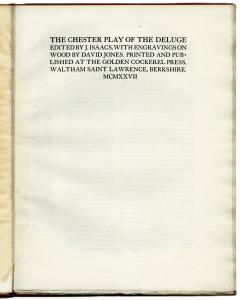
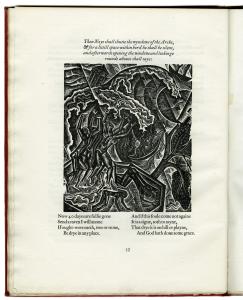
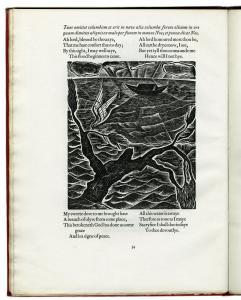
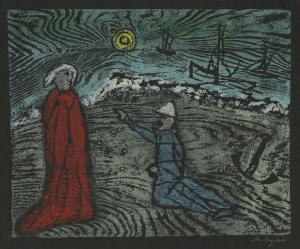



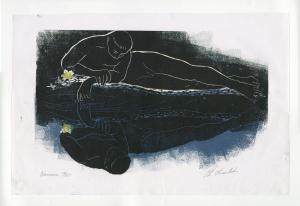
![Untitled [Man and Mermaid Embracing] from the portfolio Abaeté: Dez Xilogravuras de Calasans Neto](/sites/default/files/styles/exhibition_thumbnail/public/2025-04/2008.18.3.8_det_0.jpg?itok=E1xnbpoE)


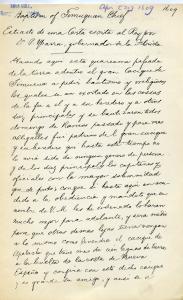
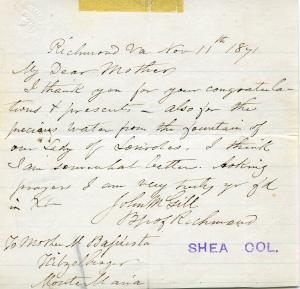
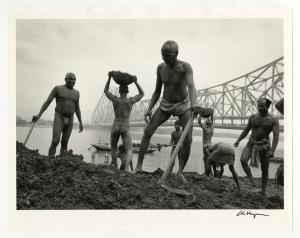
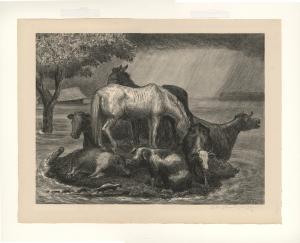



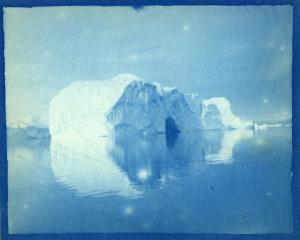

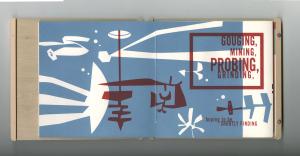
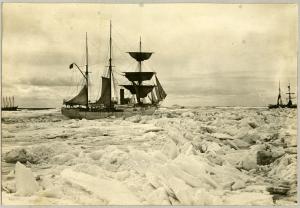

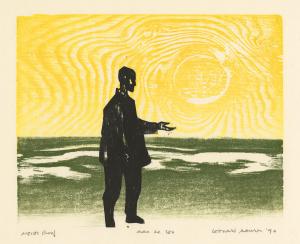
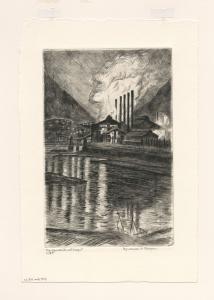


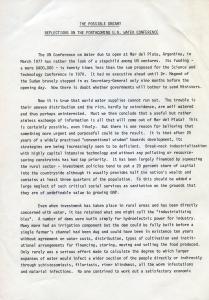

![Descendencias [Descendants] for Das Wasser calendar, 2023](/sites/default/files/styles/exhibition_thumbnail/public/2025-04/2024.1.1.1_det_0.jpg?itok=sSkkv_zH)
